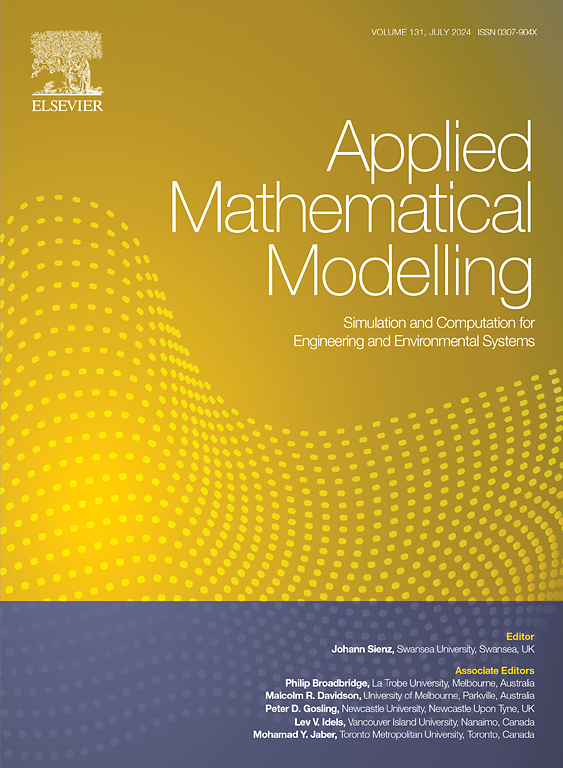采用适当的正交分解方法对边界条件不确定的热传导问题进行数据驱动模型误差修正
IF 4.4
2区 工程技术
Q1 ENGINEERING, MULTIDISCIPLINARY
引用次数: 0
摘要
在数字孪生等应用中,模型必须结合高精度和低计算成本。降阶建模(通常涉及降维)以及数据驱动的模型错误纠正,可以使实现这两个目标成为可能。我们重点关注使用适当的正交分解(POD),以及来自可用的基于物理的模型的示例解决方案,对降阶模型执行降维,以及在使用数据驱动模型进行校正时必须考虑的事项。如果在POD过程中只使用最佳可用全阶模型的样本解,那么在数据驱动的纠错模型甚至被训练之前,修正模型的准确性可能会受到限制,因为真正的解域不能在POD子空间中表示。为了克服这个问题,我们提出了基于反映全阶模型中预期不确定性的样本解扩展POD子空间。用两个边界条件不确定的热传导算例对该方法进行了验证。结果表明,扩展后的POD子空间允许修正后的模型优于原全阶模型,而原POD子空间不允许。本文章由计算机程序翻译,如有差异,请以英文原文为准。
Using proper orthogonal decomposition for data-driven model error correction for heat conduction problems with uncertain boundary conditions
In applications such as digital twins, models must combine high accuracy with low computational cost. Reduced order modelling, often involving dimensionality reduction, together with data-driven model error correction, can make it possible to achieve both objectives. We focus on the use of proper orthogonal decomposition (POD), together with sample solutions from the available physics-based models, to perform dimensionality reduction for reduced-order models, and on considerations that must be made when these are to be corrected using a data-driven model. If only sample solutions from the best available full-order model are used in the POD procedure, the accuracy of the corrected models may be limited before the data-driven error-correcting model is even trained, because the true solution fields cannot be represented in the POD subspace. To overcome this problem, we propose expanding the POD subspace based on sample solutions reflecting anticipated uncertainty in the full order model. The proposed method is demonstrated using two examples involving heat conduction with uncertain boundary conditions. The results show that the expanded POD subspaces allow the corrected models to outperform the original full-order model, while the same is not true for the original POD subspaces.
求助全文
通过发布文献求助,成功后即可免费获取论文全文。
去求助
来源期刊

Applied Mathematical Modelling
数学-工程:综合
CiteScore
9.80
自引率
8.00%
发文量
508
审稿时长
43 days
期刊介绍:
Applied Mathematical Modelling focuses on research related to the mathematical modelling of engineering and environmental processes, manufacturing, and industrial systems. A significant emerging area of research activity involves multiphysics processes, and contributions in this area are particularly encouraged.
This influential publication covers a wide spectrum of subjects including heat transfer, fluid mechanics, CFD, and transport phenomena; solid mechanics and mechanics of metals; electromagnets and MHD; reliability modelling and system optimization; finite volume, finite element, and boundary element procedures; modelling of inventory, industrial, manufacturing and logistics systems for viable decision making; civil engineering systems and structures; mineral and energy resources; relevant software engineering issues associated with CAD and CAE; and materials and metallurgical engineering.
Applied Mathematical Modelling is primarily interested in papers developing increased insights into real-world problems through novel mathematical modelling, novel applications or a combination of these. Papers employing existing numerical techniques must demonstrate sufficient novelty in the solution of practical problems. Papers on fuzzy logic in decision-making or purely financial mathematics are normally not considered. Research on fractional differential equations, bifurcation, and numerical methods needs to include practical examples. Population dynamics must solve realistic scenarios. Papers in the area of logistics and business modelling should demonstrate meaningful managerial insight. Submissions with no real-world application will not be considered.
 求助内容:
求助内容: 应助结果提醒方式:
应助结果提醒方式:


